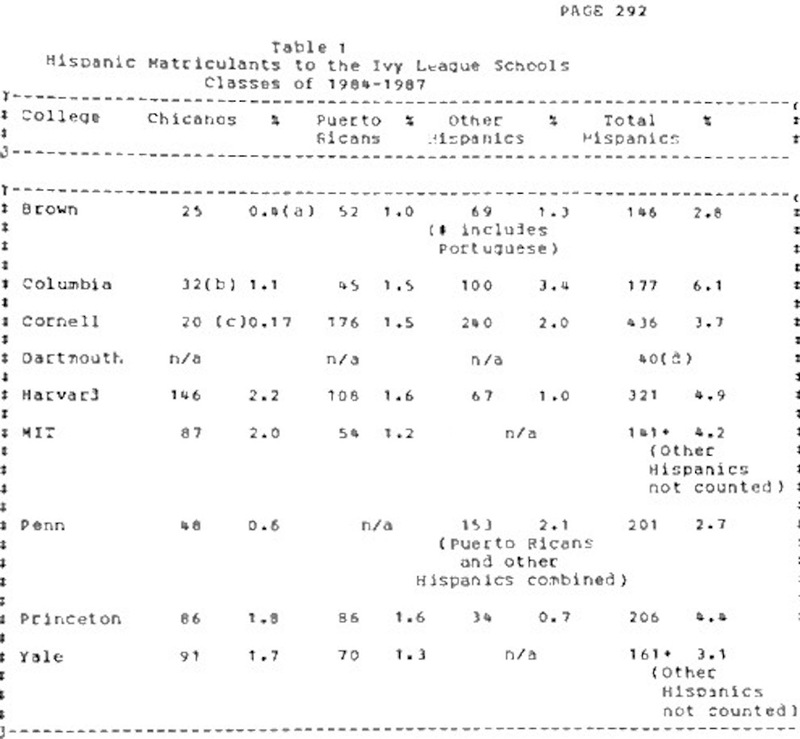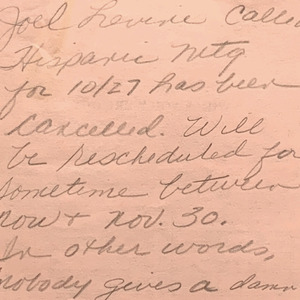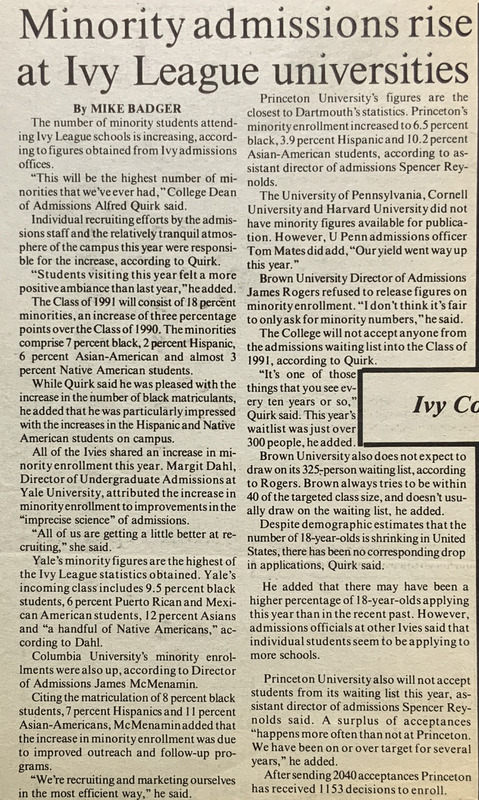Limited Progress: Evolution of Dartmouth's Latinx Recruitment
Dartmouth’s administration in the 1970s and 1980s under-recruited Latinxs compared to other minority groups. Written records reveal that Dartmouth eschewed formal recruitment programs in favor of cost-minimizing alternatives such as refurnishing Latin American Studies (LATS) classes, resulting in fewer Latinx admissions than other Ivy League institutions. This was only partially reversed through pressure by figures like Professor Marysa Navarro, who insisted that Dartmouth take Latinx recruitment more seriously. Dartmouth’s Latinx under-recruitment during this period must be contextualized in two lights:
Nationwide Neglect of Latinx Students
First, it was set in an educational milieu where schools across the nation neglected Latinx Americans. A 1996 report by the President's Advisory Commission on Educational Excellence for Hispanic Americans (PACEEHA)—a Department of Education working group—explains that in the late 20th century, Latinx Americans were systematically ignored in both faculty hiring and student recruitment, resulting in a “persistent gap in educational attainment" compared to other Americans. This partially explains Dartmouth’s apathy: other institutions were also undervaluing Latinx representation.
Dartmouth's Past Recruitment of Minority Groups
Second, Dartmouth had previously demonstrated that it was capable of improving its recruitment strategy for specific racial minority groups. In particular, Dartmouth had been improving its African-American recruitment during its period of Latinx student neglect. Anne Johnakin's exhibit "The Multiplier Effect: Recruitment and Bringing Dartmouth Home" shows that in Dartmouth’s class of 1969, black students were similarly grossly underrepresented in Dartmouth’s student population: only 15 of the 900+ students were black.
Major improvements were driven by black student activism and demands. Junelle Matthias' exhibit "In Order to Do Good, You Must First Do Well” explains that black students at Dartmouth played three key roles: engaging in targeted recruitment, advocating for expanded affirmative action, and demanding a robust Black Studies program. Targeted recruitment was a major break with Dartmouth's previous recruitment strategy. From 1966 to 1971, Dartmouth had unsuccessfully relied on their Negro Applications Encouragement program. This changed from 1971 to 1981, as black students and faculty reached out to "promising students from poorer neighborhoods and less prestigious public schools", specifically focusing on talented black high schoolers identified by the Independent Schools Talent Search Program. Expanded affirmative action had two components: one, hiring more black admissions officers; two, improving acceptance rates and financial aid offers for black applicants. The insistence on a Black Studies program led to the creation of the African and African American Studies department, which made black students and applicants feel "uplifted...and more welcome."
The combination of these efforts "played a significant role in attracting black students" by 1981. In 1972, only 93 black students applied to Dartmouth; in 1981, 254 black students applied to Dartmouth. In 1972, only 49 black students were admitted; in 1981, 134 were admitted.
Dartmouth's Latinx Recruitment "Lagged Behind"
But Dartmouth’s Latinx representation was still unusually egregious on two levels. First, it was far lower than other prestigious institutions. Public admissions statistics reveal that while Brown, Columbia, Cornell, Harvard, MIT, Penn, Princeton, and Yale each had over 140 Latinx matriculants in 1984-1987, Dartmouth only had 40 during this period. Second, it lagged behind the fast growth of Latinxs in New Hampshire (NH). While the Latinx population of NH was meteorically growing in the 1980s, the Latinx population of Dartmouth was not. This growing diversity around Dartmouth further highlighted the lack of Latinx students inside Dartmouth.
This phenomenon makes more sense after understanding Dartmouth’s dubious recruitment strategy. In a 1987 memo, administrator Dwight Lahr revealed the college’s plan to shun formal Latinx recruitment programs in favor of further improving the “Latino Studies concentration”, which he claimed would “meet the [recruiting] challenges...without further expense." Lahr’s justification was that “the anticipated incremental academic costs should be significantly less than those projected” from a formal Latinx recruitment program, because they could be covered with the preexisting budget instead of requiring new expenditures. The obvious pretext was that recruiting Latinx students was too unimportant to waste money on.
"[Improving] the Latino Studies concentration...meet[s] the challenges...without further expense."
—Dwight Lahr
Contrasting Dartmouth's Frugality with Chicano Demands
It is important to contrast Dartmouth's penny-pinching in the 1980s with the “curricular change” demanded by certain Chicano activists in California during the 1970s. In his 2011 book on Chicano studies, Michael Soldatenko describes how Chicano activists historically demanded that colleges create Chicano studies programs “institutionalized under Chicano control...[to] recruit Chicano(a) students, faculty, and staff." Pedro Cabán details the two notable components of these demands. First was curriculum: Chicano activists wanted an educational curriculum that emphasized their role in the formation of the U.S, and challenged traditional social scientific analyses of Chicano displacement and oppression which were tainted by a "racially biased methodology." At the 1969 University of California, Santa Barbara conference, Chicano organizers emphasized that only this Chicano-centric curriculum would appeal to Chicano students, as alternate historical presentations would fail to "place value on what we value" and enable "the development of our community." The second component was Chicano control: they wanted curricular changes to be dictated by Chicano voices, not white adminstrators, and for "progressive faculty" to lead the programs.
There were several key differences between these demands and Lahr’s plan. One, Lahr did not emphasize the creation of a specifically Chicano-centric curriculum, which matters because alterantive curricula tended to "sanitize" the wrongdoings of Anglos driven by Manifest Desinty. Two, there were distinctions regarding for whom and why Chicano studies curricula were being created. These activists wanted Chicano control over Chicano studies departments, which would attract students by transforming colleges into “space[s] controlled by Chicanos(as) for Chicanos(as)." In contrast, Lahr’s plan for curricular improvement had no such intention of establishing Chicano control.
Navarro's Pressure on Dartmouth's Adminstration
Marysa Navarro thus criticized Lahr’s recruitment plan as incomplete. In a 1987 memo to Lahr, Navarro scathingly argued that while his strategy was cheaper, it would be ineffective at increasing Latinx student yield since “the issue of a Latin American Studies program is completely separated" from Latinx recruitment. Navarro observed that it is possible to have a Latino Studies program yet have few Latinx students on campus, as shown by other colleges with LATS curricula yet low Latinx representation. As a result, she believed that formal recruitment programs should be “independently” pursued.
Navarro’s passion about Latinx recruitment is best appreciated after grasping her legacy as an “agent of change at Dartmouth." Before fighting for increased Latinx representation at Dartmouth, Navarro fought for other causes, most notably the integration of women into Dartmouth. In the 1970s, a contingent of administrators insisted on building “a college across the river in order to have the women there”, which Navarro painstakingly prevented by championing a motion for integration. Navarro applied this same resilience to criticize and pressure Dartmouth’s administration into taking Latinx student recruitment more seriously. Navarro’s pressure took on three forms:
First, Navarro individually wrote letters addressed to specific faculty and administrators. For instance, her 1987 letter to President McLaughlin sharply noted that Dartmouth “has the lowest number" of Latinx students among Ivy League schools, and that Dartmouth’s lack of commitment of Latinx recruitment insulted all Latinx faculty and students on campus. This was especially insulting because non-Latinx groups were receiving attention instead. A 1979 article in The Open Forum, "Latinos At Dartmouth" (exhibited below), points out that despite efforts to recruit “blacks, Native Americans, and women”, the college deemed Latinx recruitment as a secondary, unimportant issue, despite the large number of Latinxs in the U.S. population. This disparity further fueled Navarro’s anger.
Second, Navarro wrote personal notes detailing this frustration. One scrap note (exhibited below) expressed her anger over a meeting regarding Latinx recruitment being canceled and being tentatively rescheduled for a month later. She angrily declared that “nobody [in Dartmouth’s administration] gives a damn”, foreshadowing her later efforts to elevate Latinx recruitment on the agenda.
Third, Navarro made her feelings known through group letters and petitions. In a note to President Freedman, co-signed by roughly 50 other professors, Navarro expressed her frustration that the trustees were “unwilling to grant additional funds" for a Latinx recruitment program. She noted that while Latinxs “will be the largest [minority group] by the year 2000”, Dartmouth had done nothing to proportionally increase its Latinx representation. While other peer schools were increasing theirs—e.g. Harvard (6.1%), MIT (4.2%), etc.—Dartmouth stagnated at 0.9%. Navarro contended that if Dartmouth failed to reverse course and fund Latinx recruitment, it would be complicit in “racism” and “anti-intellectual[ism].”
"Nobody [in Dartmouth’s administration] gives a damn [about Latinx student recruitment]."
—Marysa Navarro
Navarro's Pressure had Mixed Success
Racial homogenization refers to the process of treating distinct racial groups as the same. It is problematic because it erases the unique features, cultures, and identities of the groups being homogenized.
The pressure that Navarro and others exerted only had partial success: while it improved Latinx admissions, it also led Dartmouth adminstrators to racially homogenize Latinx and black students. On one hand, it forced Dartmouth to create formal Latinx recruitment strategies, which did in fact increase yield. Statistics from The Dartmouth demonstrate that due to newly adopted “individual recruiting efforts”, Dartmouth’s accepted Latinx students jumped to 2% in 1991: over a double in increase. On the other hand, it also inadvertently led to racial homogenization, as white administrators figured that Latinxs were similar enough to black people to merit similar recruitment strategies. In a 1987 letter, Joel Levine betrayed this presumption by declaring that Dartmouth’s “dual program” for Latinx recruitment should mimic that used to recruit “South African blacks.” While this technically satisfied Navarro’s insistence on a “formal recruitment program”, it simultaneously reduced the complexity of race to a trivial white vs. non-white binary. This is particularly important given how the fields of Chicano and Latino studies had been developing complex accounts of race and identity. For instance, a key aspect of the aforementioned Chicano activist demands in California was that college curriculums emphasize the "uniqueness" of Chicano identity and the particularities of their oppression. Through racial homogenization, Dartmouth adminstrators erased all of these nuances.
Takeaways and Future Research Directions
While the evolution of Dartmouth's Latinx recruitment strategy in the late 20th century appears mostly positive, a nuanced analysis reveals that it was not a total panacea. Figures like Navarro were able to pressure Dartmouth into spending more on Latinx recruitment, but behind the improved admissions numbers, the school and its adminstrators remained wed to racist attitudes such as racial homogenization. It is thus important to acknowledge that progress during this period was highly limited.
It is also important to note that official statistics show that Dartmouth's current freshman class, the class of 2025, is 12% Latinx: a dramatic improvement from 2% in 1991. As a topic of future research, it would be fruitful to study what further shifts in recruitment strategy occurred between 1991 to today to advance these improvements in Latinx representation.





